There may be spoilers here, but why on earth would you read an analysis before watching the film?!
Producer: Jack L. Warner
Director: George Cukor
Screenplay: Alan Jay Lerner
Starring: Audrey Hepburn and Rex Harrison
Images are from the WHV 2004 SE release.
My Fair Lady is a musical adaptation of the stage play by the same name, which is in turn, an adaptation of George Bernard Shaw's Pygmalion. I'm only going to talk about the film because what ultimately matters is on the screen.
I want to discuss several scenes that I feel are worthy of analysis and put them into a larger context.
The Ascot Scene
I'd consider the scenes and dance number at the Ascot racing fields to have the most satiric bite in the film. The establishing shot shows the aristocrats preparing to see the next race, and as you can see, the film isn't striving for realism:
The scene can be taken as simply a classy fashion show, and I'm sure those into fashion will love the scene because of that. Looking at the scene more closely, however, we can see the film commenting on high society (and to some extent, it's a critique of the class system in general). Consider how stiff and pontifical the actors are, striking poses like this:
They certainly are an excitable bunch, aren't they? Here they are singing: "Pulses! Rushing!":
"Faces! Blushing!"
"Heartbeats! Speed-Up!":
There seems to be an elegant sort of fencing going on between them. This passive-aggressiveness in high society is seen in a lot of films (remember that smug kid in my Bicycle Thieves post?). I suspect social sparring goes on in all classes, it's just that the aristocracy demands you be subtle about it.
I think there is some excellent use of hats. The ungainly things create distance between these two ladies sneering at one another:
Hats are also used as a shield. The scene is actually quite funny as a satiric piece, such as this lady blocking the man trying to "socialize" (it's best seen in motion):
I suppose a case could be made for feminism as well. The hat size could indicate how guarded and strong a woman is. This would work well for Eliza Doolittle, who has just about the biggest hat in the scene. Come on Dover! Move yer bloomin' Arse!:
Freddy and Stalkerism
Before I dive into this, let me just say I think the film certainly has a feminist stand point. In the "With a Little Bit of Luck" number, we not only see an office for suffragettes, we also see a marching band of women promoting women's suffrage. One even whacks Alfred Doolittle on the noggin with her drumstick. However, it would be erroneous to say that the film is nothing but feminist propaganda. The stance leans towards feminism, but numbers like "I'm an Ordinary Man" and "A Hymn to Him" bring up valid reasons why a man should stay serenely independent. Henry Higgins is no weaker than Eliza Doolittle and vice-versa.
Which brings us to Freddy. He is a purposefully weak character, smitten by "love-at-first-sight" and pulls up a chair right next to Eliza:
Again, those wonderful hats work brilliantly. Looking at the composition, we see that Freddy is always positioned to Eliza's right, so her hat blocks him. Freddy can, to some extent, be seen as a menacing stalker:
Jeremy Brett (who plays Freddy) is a fine actor whom I especially like for his Sherlock Holmes role on A&E. When I say "stalker" I mean this a little tongue-in-cheek. I don't think he's some perverted stalker that lusts for Eliza. I think it's safe to say he's quite harmless and merely has a big time adolescent crush on her.
His big number "On the Street Where You Live" certainly has stalker-like implications, but in no way is he like Bob Rusk in Hitchcock's Frenzy. When he tells Mrs. Pierce he'll be happier staying outside drinking in the street where Eliza lives, I'm certain he's just like any young man who's naively high on love-at-first-sight. Anyway, Mrs. Pierce just shrugs him off, like the silly boy he is. He stays pretty much locked up during his singing number, squished in a flowery sort of daze:
I think the film warns us of this naivete of "love-at-first-sight" and how dangerous and stupid it really is. Freddy is often seen impaled (by mise en scene) with the grid-iron fences, juxtaposed with the flowers.
I think Freddy is engaged in a mild form of stalkerism. At the end of his number and the beginning of his reprise, we see him exit and enter from the same position:
Eliza is smart enough to avoid such traps that befall poor young Freddy and this is where I think Audrey Hepburn's casting has an advantage over Julie Andrews (who created the role on Broadway and London; or maybe I'm just reaching for a point). She was 6 years older than Ms. Andrews and already had over 15 years experience, whereas Ms. Andrews was just getting started. I think her experience provides implications to her maturity, which behooves her character. Her persona also involved playing women who undergo transformations (Roman Holiday, Sabrina, Funny Face), which is perfect for My Fair Lady. I will not delve into the dubbing issue because I believe it is of no concern to appreciate the film. Anyway, I think Ms. Hepburn is incredibly expressive in play-acting (see Stanley Donen's Charade), and a movie's number one concern is the visual. Cinema is full of illusions and smoke and mirrors anyway. To quote Jean-Luc Godard: "Cinema is the most beautiful fraud in the world."
I think my favorite number is "Show Me." The scene perfectly illustrates Eliza's character and attitude. I think Eliza's outfit pretty much says it:
It makes her seem headstrong and tough, unlike her embassy ball outfit, which to me made her seem vulnerable. Maybe it has to do with the amount of neck showing? I'm not sure, since I don't know squat about fashion. In the film, I think it's pretty obvious that Eliza never seriously considers Freddy. When she says she'll marry him, I'm pretty sure she's just saying that to ruffle Higgin's feathers and maybe break his fortitude. Apparently, the play Pygmalion does have her marry Freddy as G. B. Shaw explains. I think My Fair Lady works well, however, partly because the ending is a bit ambiguous (I usually like a little ambiguity).
The "Show Me" number also makes great use of the sets. Here we see Freddy caged and forever distanced from Eliza, like the poor fool he is:
There's always something between them (Higgins), represented by the fence. I also think Ms. Hepburn's physical acting talents are exceptional. Her confident persona is something to admire, and it's pretty funny how she chides Freddy for his naivete, who is still so blissfully oblivious and obliviously blissful:
Romance?
I think it's clear in the film that Eliza has feelings for Higgins and vice-versa. This is best seen at the Embassy ball. When they are ready to go, Higgins pauses and returns to take Eliza's arm, indicating he regards her as a lady and maybe even an equal. At the ball, he dances with her, but when he passes her off to the Hungarian Zoltan Karpathy (Theodore Bikel), her expression changes from elated to despondent. It's clear, at least, that she would like nothing better than Higgins' respect, and that Higgins is conflicted as to whether he should give it to her. He constantly alternates between kindness ("I suppose you've never wondered if I could get along without you") and condescendence ("... and Eliza, you're a fool!" or "you impudent hussy!").
So is this a romance?
Well, the only kiss in the entire film is between these two:
The film is ranked 12th on the American Film Institute's "100 Years... 100 Passions" list which ranks the great love stories in cinema. Of course, AFI makes loads of silly choices so I wouldn't give it too much credence.
If the relationship between Higgins and Eliza can be considered a romance, I'd say their relationship isn't like this:
but more like this:
Which is, of incident, another film that places a very strong woman at its center. Comparing Henry Higgins and Eliza Doolittle to Hannibal Lector and Clarice Starling works for me. It's not so much that they love each other like Freddy loves Eliza. It's more like they are perfect for one another because they are so quick-witted and their verbal sparring becomes a necessity. I think the attraction is between their minds, not their bodies, and this seems to be one of the underlying messages in the film. Trust your intellect, not your heart. Which is not to say ignore the heart completely, just don't let it lead you down the wrong path... since hearts are known to have ADD. The film's final image is also ambiguous to their relationship. "Eliza? Where the devil are my slippers?"
I think the film is also pretty opposed to marriage, for love or status. Consider that none of our beloved characters are married. Higgins is a confirmed bachelor along with Colonel Pickering. Higgins' mother is never seen with a husband or any other man. Eliza's father, Alfred Doolittle (Stanley Holloway), prefers not marrying her stepmother to maintain his dustman ethics. His "fortunes" do change, and after meeting Higgins, he is placed on the will of a benefactor interested in moral reform. With 4000 quid a year, he's tied up in middle class morality. Eliza's stepmother now wants to marry him, so they can be "respectable." It's pretty obvious that in the "Take Me to the Church" number, he's celebrating his last night as a bachelor. At the end of it, he must go to the church, in funereal style:
I'm sure there are many more analyses to be made, yet it seems people only want to talk about how entertaining it is (which it is) or the film that should've had Julie Andrews. I think we should cherish what's there and realize what an incredibly intelligent film it is. On the whole, I think My Fair Lady is a vastly underrated work of art.
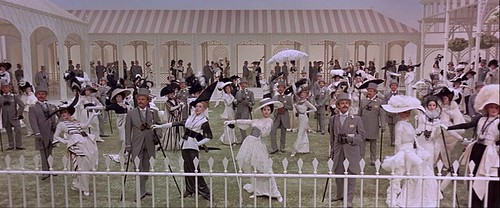
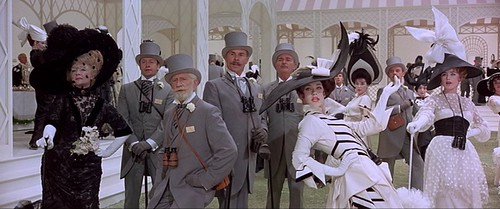
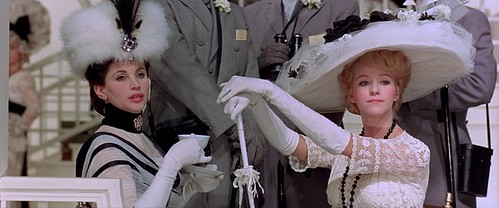
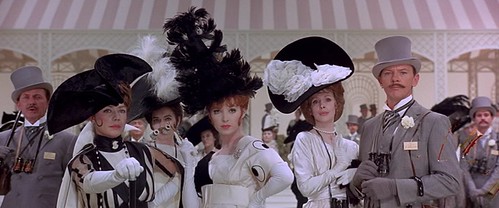
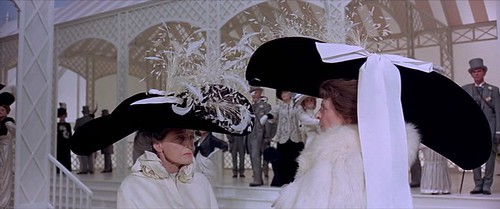

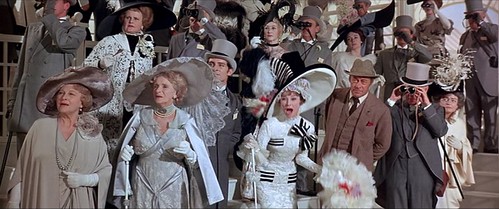
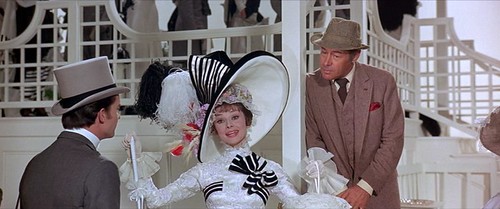
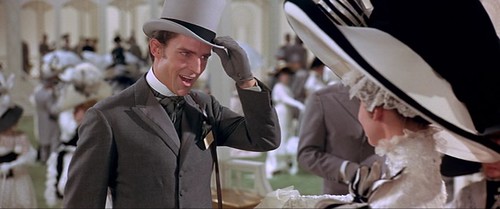
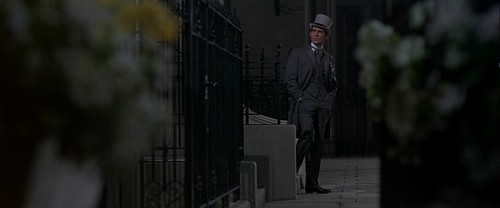
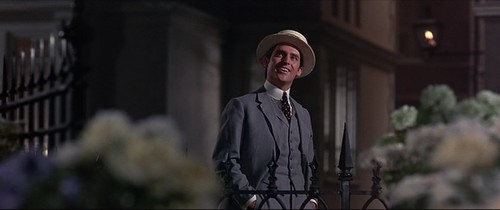
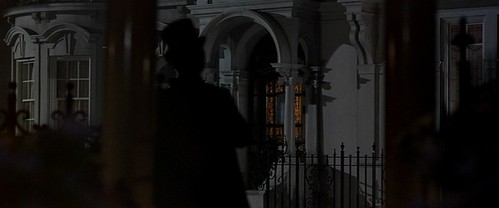
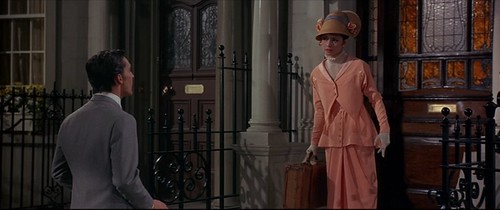

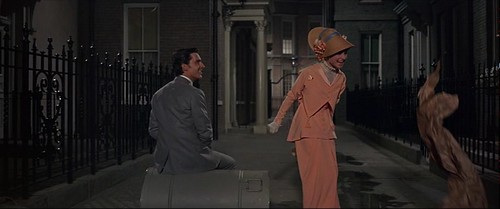
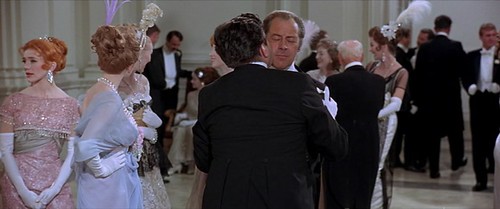
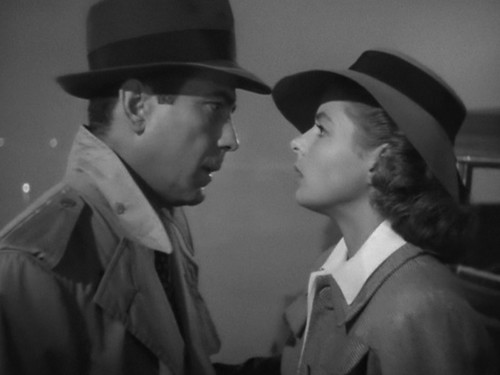
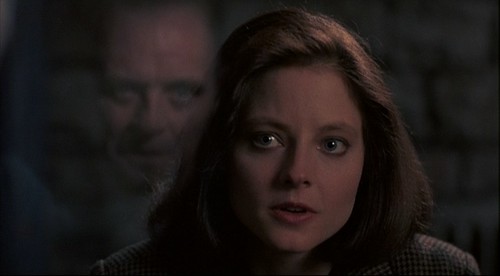


This is an analysis of the first water. You did it!
ReplyDelete